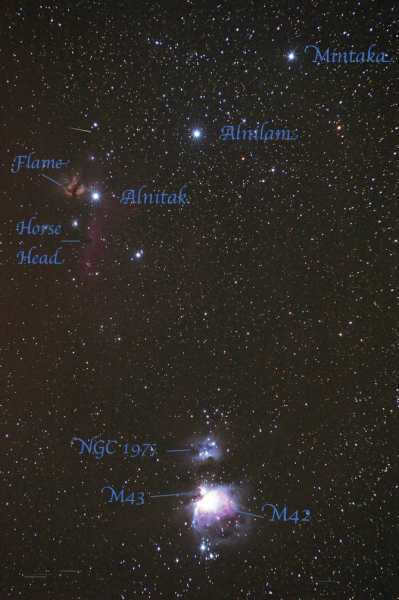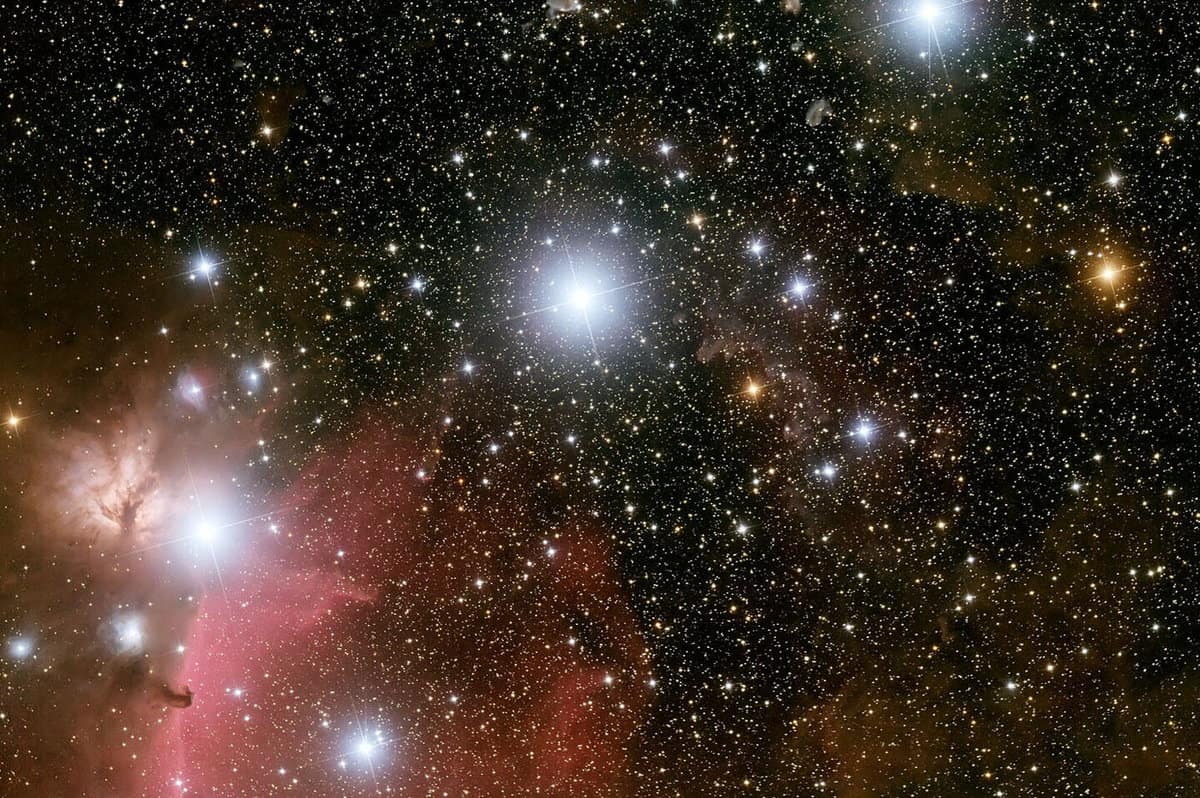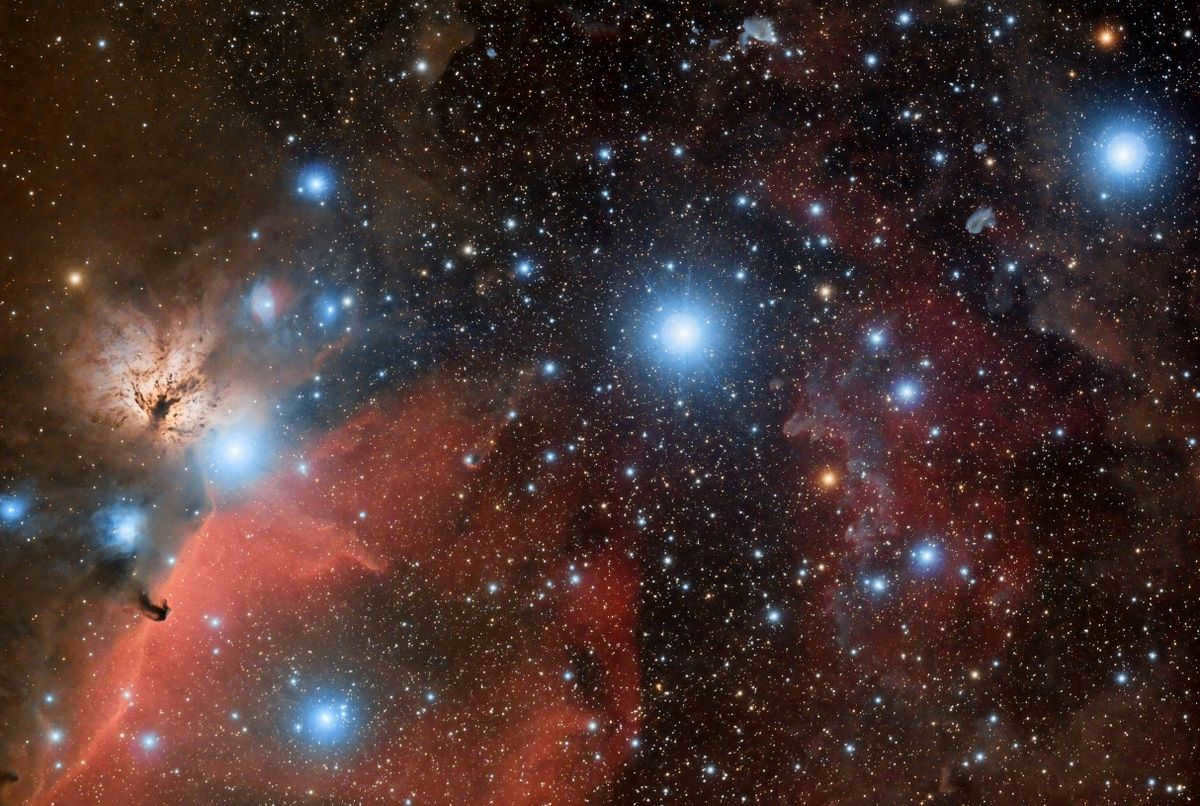

Alnitak is a triple star situated in the Orion constellation, approximately 817-825 light-years away from the Sun, which is about 250 parsecs. It is part of an asterism known as Orion’s belt, along with the stars Alnilam and Mintaka. In the Arabic language, Alnitak translates to “Kushak” or “cloth belt.”
Orion’s zeta is composed of three stars:
Component Aa
- Mass – 23 – 43 solar masses
- Radius – 16.8 – 23.2 solar radii.
- Temperature – 28,500 – 29,500 K
- Luminosity – 160,000 solar luminosities
- Age – 7 million years
- Spectral class– 5Iab
The primary star in the Alnitak triple star system is a hot blue supergiant, which is the most brilliant star of its kind observable in the night sky.
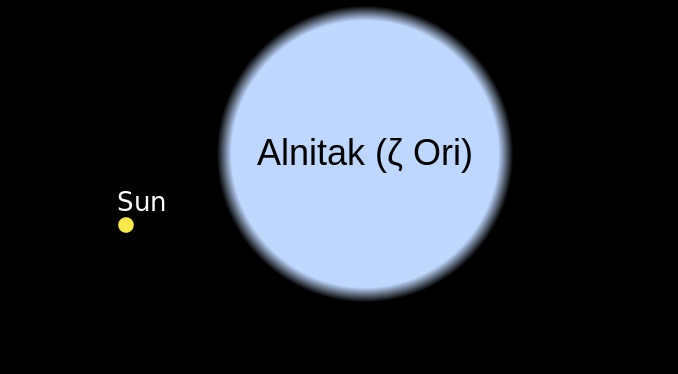
A comparison is made between the sizes of the Sun and Alnitak Aa.
Component Ab
- Mass – 11 – 17 times the mass of the Sun
- Radius – 6.3 – 8.3 times the radius of the Sun
- Temperature – 29000 K
- Luminosity – 31,600 times the luminosity of the Sun
- Age – 7 million years
- Spectral class – B1IV
Component Ab revolves around the primary star Aa and together they form a close binary star system.
Component B
- Mass – 16 solar masses.
- Radius – 7.2 solar radii.
- Temperature -29,000 K.
- Luminosity – 35,600 solar luminosities.
- Age – 7 million years
- Spectral class – B0III
Additionally, Component B orbits around Aa in a duration of 1500 years.
Observational data shows that Component B has a direct ascension of 05 h 40 m 45.5 s and a declination of -01° 56′ 34″. Its apparent stellar magnitude is 1.77.
The Zeta Orion triple star system is situated within the IC 434 nebula, which is a luminous cloud of ionized gas emitting visible light. Interestingly, this nebula is also the backdrop for a dark nebula known as the Horsehead.
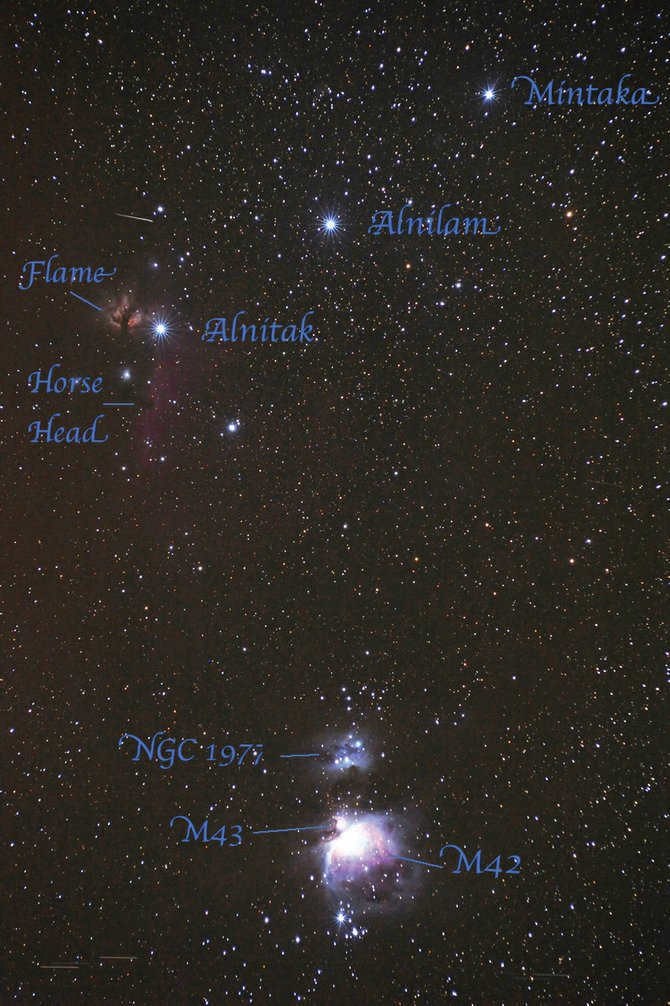
The celestial bodies known as Alnitak, Alnilam, and Mintaka, along with the majestic Horsehead Nebula and the remarkable M42.
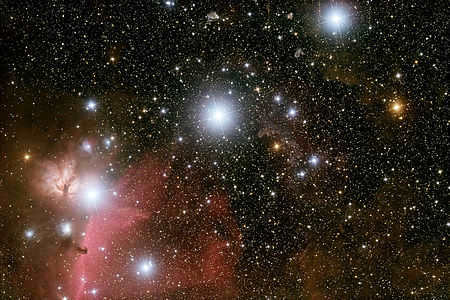

Mintaka, located in the constellation of Orion, is one of the three brightest stars that make up Orion’s belt. Mintaka can be found on the western side of the belt.
Mintaka, also known as δ Orionis, 34 Orionis, 88 G. Orionis, FK5 206, Hips 25930, 4134 AD, CCDM J05320-0018, and WDS J05320-0018.
Mintaka / ˈmɪntəkə /, [13] is the name given to a star system known as Orion delta (δ Orionis, abbreviated as Delta Ori, δ Ori) and 34 Orionis (34 Ori). It is located about 1200 light-years away from the sun in the Orion constellation. Along with Alnitak (Zeta Orionis) and Alnilam (Orion’s Epsilon), these three stars make up Orion’s Belt, which has been referred to by various names in ancient cultures. Mintaka is positioned very near the celestial equator. When Orion is close to the meridian, Mintaka can be seen as the rightmost star of the Belt when observed from the Northern Hemisphere facing south.
Nomenclature
Orion Delta is a celestial object known as 34 Orionis according to the Bayer designation. It is also referred to as Mintaka, a name derived from the Arabic word for “belt” – منطقة or Manṭaqa. [14] In the year 2016, the International Astronomical Union established the Working Group on Stellar Names (WGSN) [15] with the purpose of categorizing and standardizing proper names for stars. The first bulletin of the WGSN, released in July 2016, [16] featured a table containing the initial two sets of names approved by the WGSN, which included Mintaka (Mintaka) for this specific star. Consequently, it has been included in the IAU Catalog of Stellar Names. [17]
Observational history
The position of the δ star in Orion’s belt (circled) is depicted on a standard star chart that focuses on the southern or upper sky when viewed from northern latitudes. In the Southern Hemisphere, the star is typically seen on the left when looking towards the northern sky.
Mintaka, one of the three stars in Orion’s belt, is located in the westernmost position. It is easily visible without the aid of a telescope, being one of the most luminous stars in the celestial sphere, and has been documented since ancient times.
Star System
δ Orionis is a star system with multiple stars. There are two stars with a magnitude of 7 located about 52 arc seconds away from the main star, which has a magnitude of 2. In between these stars, there is another star that is much dimmer. This star system is known as WDS 05320-0018 in the Washington Double Star Catalog. The companion star, which has a magnitude of 14, is listed as component B, and the star with a magnitude of 7 is listed as component C. [20]
The main component of this system is a triple system. It consists of a bright giant star with a classification of O9.5 and a main sequence star with a classification of B. These two stars orbit each other every 5.73 days and occasionally show minor eclipses when the brightness of the system decreases by about 0.2 stellar magnitude. Additionally, there is a subgiant star with a classification of B that can be resolved at a distance of 0.26 inches. [3] During a primary eclipse, the apparent magnitude of the entire system drops from 2.23 to 2.35, while during a secondary eclipse it only drops to 2.29. [21]
The companion star, HD 36485, is a B-type main-sequence star with peculiar chemical properties. It is a double star with an A-type companion that orbits it in 30 days. The star’s spectrum is unique, showing H-alpha emission and a strong absorption line of helium. It also has a powerful magnetic field and rotates at a very slow speed, causing a stratification of its atmosphere and resulting in the unusual spectrum observed. [8]
The companion star, which has a magnitude of 14, is believed to be located at a similar distance to HD 36485. It is slightly cooler and less luminous than the Sun. [11]
Mintaka is surrounded by a group of faint stars, which may be part of the cluster that surrounds σ Ori. [22]
Distance
The distance is calculated based on the parallax of the Hipparcos satellite, which is 212 ± 30 pc. However, when comparing the spectral distances, similar stars, and cluster membership, it suggests a distance that is more than twice the value obtained from the satellite. This discrepancy is not unique to Mintaka and the reasons behind it are still unclear. In the Gaia 2 Data Release, components B and C have parallaxes of 3.4531 ± 0.0371 mas and 2.5727 ± 0.0767 mas, respectively, indicating much larger distances than the main source obtained from Hipparcos.
Origin and cultural importance
Astrologers believed that Mintaka was an omen of good luck. [14]
The belt of Orion

The three stars of the Belt in the constellation of Orion have been given various names throughout different cultures. Some Arabic terms for these stars include Al Nijad which means ‘Belt’, Al Nasak which means ‘line’, and Al-Alqat which translates to ‘Golden grains or nuts’. In modern Arabic, they are referred to as Al Mizan al Shaqq which means “A ray of precise scale”. In Chinese mythology, they were also known as a weight beam. [ citation needed ]
In Chinese, the term 參 宿 (Sheng So), which means ‘Three stars (asterism)’, is used to refer to the asterism consisting of Mintaka, Alnilam, and Alnitak (Orion’s Belt). Later on, Betelgeuse, Bellatrix, Saif, and Rigel were added to this group. [25] Therefore, the Chinese name for Mintaka is 參 宿 三 (Shen S san), which translates to ‘the third star of three stars’ in English. [26] This asterism is considered one of the western mansions of the white tiger.
Related Links
Recommended Sources
- ^ abcdefg van Leeuwen, F. (2007). "Confirmation of the new Hipparcos contraction". Astronomy and Astrophysics. 474 (2): 653-664. arXiv: 0708.1752 . Bibcode:2007 A&A . 474..653V. DOI:10.1051/0004-6361:20078357. S2CID18759600. Vizier catalog entry
- ^ abc Hoffleit, Dorrit; Jaszczek, Carlos (1991). The catalog of Bright Stars (5th revised ed.). New Haven, CT: Yale University Observatory. Bibcode:1991bsc..book . H.
- abc Tokovinin, A. A. (1997). "MSC – catalog of physical multiple stars". Astronomy and Astrophysics Supplement Series. 124: 75-84. Bibcode:1997A and AS..124 . 75 tit… doi: 10.1051 / aas: 1997181 .
- ab Zacharias, N .; Finch, C. T .; Girard, T. M .; Henden, A .; Bartlett, J. L .; Monet, D. G .; Zacharias, M. I. (2012). "VizieR online data catalog: the UCAC4 catalog (Zacharias +, 2012)". VizieR Online Data Catalog: I / 322A. Bibcode:2012gCat.1322 . 0Z.
- abcdef Harvin, James A .; Gies, Douglas R .; Bagnuolo, William G .; Penney, Laura R .; Tuller, Michelle L. (2002). "Separation of composite spectra using tomography. VIII. Characteristics of a large compact double system in the triple star system HD 36486 (δ Orion A)". The Astrophysical Journal. 565 (2): 1216. arXiv: astro-ph / 0110683 . Bibcode:2002ApJ . 565.1216H. doi:10.1086/324705. S2CID118957476.
- ab Høg, E .; Fabricius, C .; Makarov, V. V .; Gorodskoi, S .; Corbin, T .; Wycoff, G .; Bastian, U .; Schwekendiek, P .; Wicenec, A. (2000). "Tycho-2 Catalog "2.5 million brightest stars". Astronomy and Astrophysics. 355: L27. Bibcode:2000A and A . 355L..27H. doi:10.1888/0333750888/2862.
- ^ abcdefghijklmnopqrstuv Chenard, T .; Oskinova, L .; Hamann, W.-R .; Corcoran, M. F .; Moffat, A. F . J .; Pablo, H .; Richardson, N. D .; Waldron, W. L .; Huenemoerder, D. P .; Maíz Apellániz, J .; Nichols, J. S .; Todt, H .; Nazé, Y .; Hoffman, J. L .; Pollock, A. MT .; Negeruela, I. (2015). "Coordinated X-ray and optical campaign of the nearest massive eclipsing double, δ Orionis Aa. IV. Multi-wavelength spectroscopic analysis without LTE". Astrophysical Journal. 809 (2): 135. arXiv: 1503.03476 . Bibcode:2015ApJ . 809..135S. doi:10.1088 / 0004-637X / 809/2/135. HDL:10045/59172. S2CID14909574.
- abc Leone, F .; Bolender, D. A .; Bolton, C. T .; Buemi, C .; Catanzaro, G .; Hill, G. M .; Stift, M. J. (2010). "The magnetic field and circumstellar environment of the helium star HD36485, also known as δ Ori C". Monthly Notices of the Royal Astronomical Society. 401 (4): 2739. Bibcode:2010МНРАС.401.2739Л. doi:10.1111 / j.1365-2966.2009.15858.x .
- ab Samus, N. N .; Durlevich, O. V .; et al. (2009). "VizieR online data catalog: General catalog of variable stars (Samus + 2007-2013)". VizieR Online Data Catalog: B / gcvs. Bibcode:2009yCat . 102025S.
- ^ Pourbaix, D .; Tokovinin, A. A .; Batten, A. H .; Fekel, F. C .; Hartkopf, W. I .; Levato, H .; Morrell, N. I .; Torres, G .; Udry, S. (2004). "SB9: The ninth catalog of spectral double orbits". Astronomy and Astrophysics. 424 (2): 727-732. arXiv: astro-ph / 0406573 . Bibcode:2004A&A . 424..727P. DOI:10.1051/0004-6361:20041213. S2CID119387088.
- ^ abcde Brown, A.G.A .; et al. (Gaia Collaboration) (August 2018). "Gaia Data release 2: summary of survey content and properties ". Astronomy and Astrophysics. 616. A1. arXiv: 1804.09365 . Bibcode: 2018A & A . 616A . 1G . DOI: 10.1051/0004-6361/201833051 .
- Gaia DR2 record for this source in VizieR.
- abcd Zboril, M .; North, P .; Glagolevsky, J. V .; Betrix, F. (1997). "Characteristics of stars with high helium content. I. Their stage of evolution and helium composition". Astronomy and Astrophysics. 324: 949. Bibcode:1997 A and A . 324..949Z.
- ^ Rumrill, H. B. (June 1936). "Pronunciation of a star name". Publications of the Pacific Astronomical Society. San Francisco, CA. 48 (283): 139. Bibcode:1936PASP . 48..139R. doi:10.1086/124681.
- ^ ab Allen, Richard Hinckley (1963) [1899]. The names of stars and their meanings. New York, NY: Dover Publications. p. cm. 314. ISBN1-931559-44-9 .
- ^"IAU Working Group on Star Names (WGSN)" . Retrieved May 22, 2016 .
- IAU Working Group on Stellar Names Newsletter, No. 1 (PDF). Retrieved July 28, 2016.
- IAU catalog of star names. Retrieved July 28, 2016.
- Deslandre, H. (1900). “Variable velocity within line of sight of Orion’s delta. (Notes)”. Observatory. 23: 148. Bibcode:1900Obs.23..148Д.
- аб Hartmann, J. (1904). “Studies on the spectrum and orbit of Orion’s delta”. Astrophysical Journal. 19: 268-286. Bibcode:1904ApJ.19..268H. doi:10.1086/141112.
- ^ Mason, Brian D .; Wycoff, Gary L .; Hartkopf, William I .; Douglas, Jeffrey J .; Worley, Charles E. (2001). "The CD-ROM of Double Stars from the U.S. Naval Observatory in 2001". I. The Washington Double Star Catalog". Astronomical Journal. 122 (6): 3466. Bibcode:2001AJ . 122.3466M. doi:10.1086/323920 .
- ^ Zasche, P .; Wolf, M .; Hartkopf, W. I .; Svoboda, P .; Uhlař, R .; Liakos, A .; Gazeas, K. (2009). "A Catalog of Visual Double and Multiple Stars with Eclipsing Components". Astronomical Journal. 138 (2): 664. arXiv: 0907.5172 . Bibcode:2009AJ . 138..664Z. DOI:10.1088/0004-6256/138/2/664. S2CID17089387.
- ^ Caballero, J. A .; Solano, E. (2008). "Surrounding Alnilam (ɛ Orionis) and Mintaka (δ Orionis): A Study of Young Stars and Brown Dwarfs". Astronomy and Astrophysics. 485 (3): 931. arXiv: 0804.2184 . Bibcode:2008A & A . 485..931C. DOI:10.1051/0004-6361:200809595. S2CID16175953.
- ^ Corcoran, M. F .; Nichols, J. S .; Pablo, H .; Chenard, T .; Pollock, A. MT .; Waldron, W. L .; Moffat, A. F. J .; Richardson, N. D .; Russell, C. MP .; Hamaguchi, K .; Huenemoerder, D. P .; Oskinova, L .; Hamann, W.-. R .; Nazé, Y .; Ignace, R .; Evans, N. R .; Lomax, J. R .; Hoffman, J. L .; Gayley, K .; Owocki, S. P .; Leutenegger, M .; Gull, T. R .; Hole, K. T .; Lauer, J .; Iping, R. K. (2015). "A Comprehensive Study of the X-ray Spectrum of δ Orionis Aa, the Nearest Massive Eclipsing Double Star". Journal of Astrophysics. 809 (2): 132. arXiv: 1507.05101 . Bibcode:2015ApJ . 809..132C. doi:10.1088 / 0004-637X / 809/2/132. S2CID17339779.
- ^ Brown, A.G.A .; et al. (Gaia Collaboration) (August 2018). "Gaia Data release 2: summary of survey content and properties ". Astronomy and Astrophysics. 616. A1. arXiv: 1804.09365 . Bibcode: 2018A & A . 616A . 1G . doi: 10.1051/0004-6361/201833051 .
- Gaia DR2 recording for this source in VizieR.
- ^ (in Chinese). Chinese Constellation Myths, by Chen Jiu Jin. Published by Shufang Version Limited Company, 2005,
- ISBN 978-986-7332-25-7
- ^ (Chinese) AEEA (Astronomy Exhibition and Education Activities) Astronomy Education Information Network May 25, 2006
external links
Coordinates: 05 h 32 m 00.4 s , -00° 17′ 57″
The content of this page originates from Wikipedia. The text can be found under the CC BY-SA 3.0 Unported License. Non-text media are subject to their own specified licenses. Wikipedia® is a registered trademark of the Wikimedia Foundation, Inc. zahn-info-portal.de is an independent company and is not associated with the Wikimedia Foundation.
Mintaka, also known as Delta Orionis (δ Orionis, abbreviated Delta Ori, δ Ori) and 34 Orionis (34 Ori), is a multiple star situated approximately 1200 light-years away from the Sun in the constellation Orion. Alongside Alnitak (Zeta Orionis) and Alnilam (Epsilon Orionis), these three stars create Orion’s Belt, which holds different names in various ancient cultures. Mintaka is positioned in close proximity to the celestial equator. When Orion is near the meridian, Mintaka is the rightmost star of the Belt when observed from the northern hemisphere, facing south.
- 1 Nomenclature
- 2 Observational history
- 3 System
- 4 Distance
- 5 Etymology and cultural significance
- 5.1 Orion’s Belt
Nomenclature
The star known as Orion Delta is designated as 34 Orion in the Flemsteed system. The name Mintaka is derived from the Arabic word “manṭaqa,” which means “belt.” In 2016, the International Astronomical Union established the Working Group on Star Names (WGSN) to create a standardized catalog of proper names for stars. The first bulletin of the WGSN, released in July 2016, included a table of the initial two groups of names endorsed by the WGSN, which featured Mintaku as the name for this particular star. As a result, Mintaku is now officially listed in the IAU Catalog of Star Names.
Orion’s δ can be found in the southern or upper sky when looking from northern latitudes, as indicated on a regular star chart. In the Southern Hemisphere, it typically appears to the left when observing the northern sky.
Mintaka, one of the three stars in Orion’s belt, is located in the westernmost position. It is easily visible without the use of a telescope and is renowned as one of the brightest stars in the night sky, recognized since ancient times.
In 1900, Henri-Alexandre Deslandres conducted radial velocity measurements at the Paris Observatory. These measurements revealed that Mintaka has a variable radial velocity, indicating that it is spectrally double. However, Deslandres’ initial estimate of an orbital period of 1.92 days was proven incorrect in 1904 by Johannes Franz Hartmann. Hartmann used photographic plates taken at the Potsdam Observatory and determined that the actual orbital period is 5.7 days. Additionally, Hartmann observed that the calcium K line at 393.4 nm in the stellar spectrum does not exhibit periodic line shifts caused by the star’s orbital motion. He proposed that this discrepancy is due to the presence of a calcium-containing cloud along the line of sight to Mintaka. This groundbreaking observation marked the first detection of an interstellar medium.
The star system
δ Orion is a system consisting of multiple stars. There is a star with a magnitude of 7 located at a distance of 52 angular seconds from a second magnitude star, with a much dimmer star positioned in between them. This particular system is known as WDS 05320-0018 in the Washington Double Star Catalog, with the 14th magnitude companion identified as component B and the seventh magnitude star designated as component C.
The seventh-magnitude companion, HD 36485, is a chemically peculiar B-type main-sequence star. It is also a spectral double star, with a faint A-type companion in a 30-day orbit. What makes this star stand out is its unusual spectrum, which exhibits H-alpha emission and notably strong helium absorption lines. Additionally, it possesses a strong magnetic field and rotates at a very slow velocity, leading to chemical stratification in its atmosphere. These factors contribute to the unique abundances observed in its spectrum.
The 14th magnitude companion is believed to be located at approximately the same distance and is a star slightly cooler and less bright than the Sun.
Mintaka is surrounded by a group of faint stars, which may be part of the cluster surrounding σ Ori.
Distance
The distance calculated from the Hipparcos parallax satellite is 212 ± 30 pc, while spectral distances, comparisons with similar stars, and cluster membership suggest a value more than double that. This kind of unresolvable discrepancy is not unique to Mintaka, and the reasons behind it are still to be clarified. In Gaia Data Release 2, components B and C are listed with parallaxes of 3.4531 ± 0.0371 msd and 2.5727 ± 0.0767 msec, respectively, indicating distances much greater than the value derived from Hipparcos for the star.
Origin and cultural importance
Ancient astrologers believed that Mintaka symbolized positive outcomes and good luck.
The Three Stars of Orion
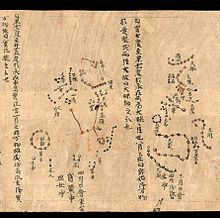
Dunhuang Star Atlas – Orion
The three stars of Orion’s belt have been known by various names in different cultures. In Arabic, they are referred to as Al Nijād “The Belt”, Al Nasak “The Line”, Al Alkāt “Golden Grains or Nuts”, and in modern Arabic, Al Mīzān al H – akk “The Ray of the Exact Scale”. In Chinese mythology, they are also known as the Scale Beam.
In Chinese, 參 宿 (Shēn Sù), meaning Three Stars (asterism), refers to the group of stars consisting of Mintaka, Alnilam, and Alnitak (Orion’s Belt), with Betelgeuse, Bellatrix, Saif, and Rigel later added. Therefore, the Chinese name for Mintaka is 參 宿 三 (Shēn Sù sān, English: Third star of three stars). It is considered one of the mansions of the White Tiger in Western astrology.
The individuals with the same names
Also check out these related articles.
Works cited
For more information, visit these external links
Coordinates: 05 32 00.4, -00° 17 ′ 57″.
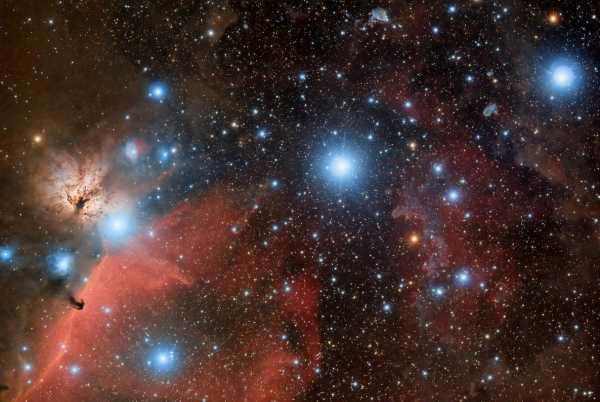

Alnitak (also known as Zeta Orionis) is a triple star system situated in the Orion constellation, approximately 817-825 light-years (about 250 parsecs) away from the Sun. Alongside Alnilam and Mintaka, it forms a famous asterism known as Orion’s belt. In Arabic, Alnitak translates to “Kushak” or “cloth belt.”
Zeta Orionis, commonly referred to as Orion’s zeta, is composed of three individual stars:
Component Aa
- Mass – 23 – 43 solar masses
- Radius – 16.8 – 23.2 solar radii.
- Temperature – 28,500 – 29,500 K
- Luminosity – 160,000 solar luminosities
- Age – 7 million years
- Spectral class– 5Iab
The primary element of the Alnitak triple star system is a high-temperature blue supergiant, which is the most brilliant star of its kind visible in our sky.
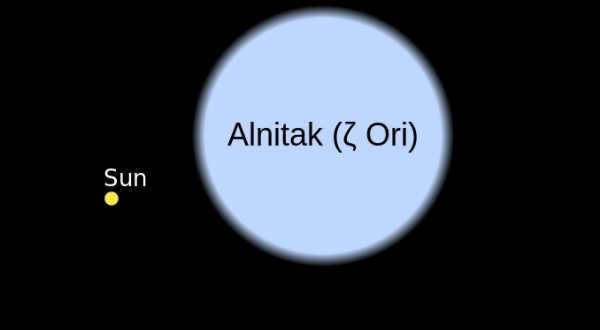
Comparison of the size of the Sun and Alnitak Aa
Component Ab
- Mass – 11 – 17 times the mass of the Sun
- Radius – 6.3 – 8.3 times the radius of the Sun
- Temperature -29000 K
- Luminosity – 31,600 times the luminosity of the Sun
- Age – 7 million years
- Spectral class – B1IV
Component Ab revolves around the primary star Aa, forming a close binary star system.
- Mass – 16 solar masses
- Radius – 7.2 solar radii.
- Temperature -29,000 K.
- Luminosity – 35,600 solar luminosities.
- Age – 7 million years
- Spectral class – B0III
Component B also orbits around Aa every 1500 years.
Observational data: right ascension – 05 h 40 m 45.5 s, declination -01° 56′ 34″, apparent magnitude 1.77.
The triple star Zeta Orion is situated in the nebula IC 434, which is a plasma cloud that emits visible light. Interestingly, the dark nebula known as the Horsehead Nebula is located against this nebula.
